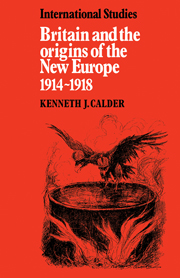Book contents
- Frontmatter
- Contents
- Dedication
- Acknowledgements
- Map
- Introduction
- 1 The initial contact
- 2 Yugoslavia in the Balkan negotiations, 1914–15
- 3 Espionage and propaganda, 1914–16
- 4 War aims, 1916
- 5 Britain and Austria-Hungary, 1917–18
- 6 The recognition of the Polish National Committee, 1917
- 7 Commitment by implication, 1918
- Conclusion
- Notes
- Bibliography
- Index
7 - Commitment by implication, 1918
Published online by Cambridge University Press: 07 October 2011
- Frontmatter
- Contents
- Dedication
- Acknowledgements
- Map
- Introduction
- 1 The initial contact
- 2 Yugoslavia in the Balkan negotiations, 1914–15
- 3 Espionage and propaganda, 1914–16
- 4 War aims, 1916
- 5 Britain and Austria-Hungary, 1917–18
- 6 The recognition of the Polish National Committee, 1917
- 7 Commitment by implication, 1918
- Conclusion
- Notes
- Bibliography
- Index
Summary
On 13 November 1917, Sobanski suggested to Balfour that the Allies launch a political offensive against Austria-Hungary in order to drive her out of the war. The methods used by the Germans to create chaos in Russia might be used with equal success against the Habsburg monarchy. The government did not seriously consider the proposal at this time because a programme designed to promote internal disorder within the Habsburg monarchy appeared to necessitate a commitment to the nationalities incompatible with the pursuit of a separate peace. As Gregory pointed out: ‘There are only two apparent forms of “political offensive” possible, a separate peace with the lesser Powers of the enemy coalition or the stirring up of nationalist strife within the Dual Monarchy.’ Should a separate peace prove to be unattainable, the use of the nationalities in a total war against Austria-Hungary was the obvious alternative. If Austria-Hungary could not be used against Germany, then the nationalities would be used against Austria-Hungary. If Austria-Hungary would not leave the war, she would be driven out.
The government did not realize at any decisive moment that a separate peace was impossible but only came to this conclusion gradually. In the same way it did not decide at any particular moment to use the nationalities in a total war against Austria-Hungary. Such significance cannot be attributed to any one decision.
Information
- Type
- Chapter
- Information
- Britain and the Origins of the New Europe 1914–1918 , pp. 175 - 213Publisher: Cambridge University PressPrint publication year: 1976
